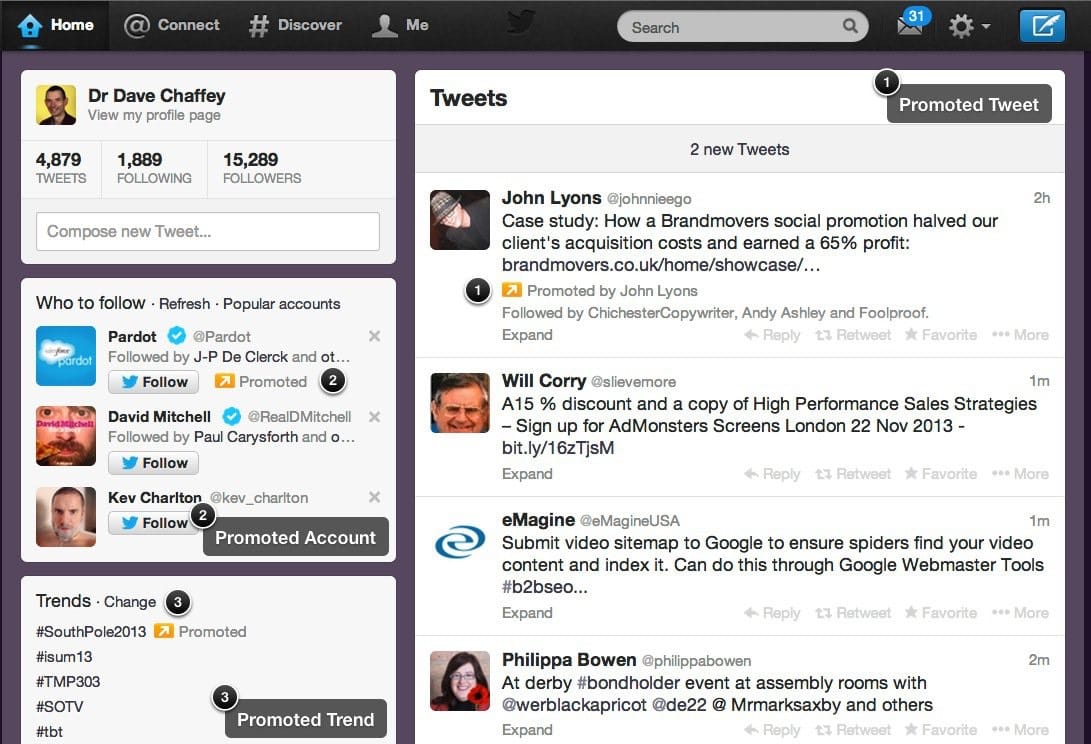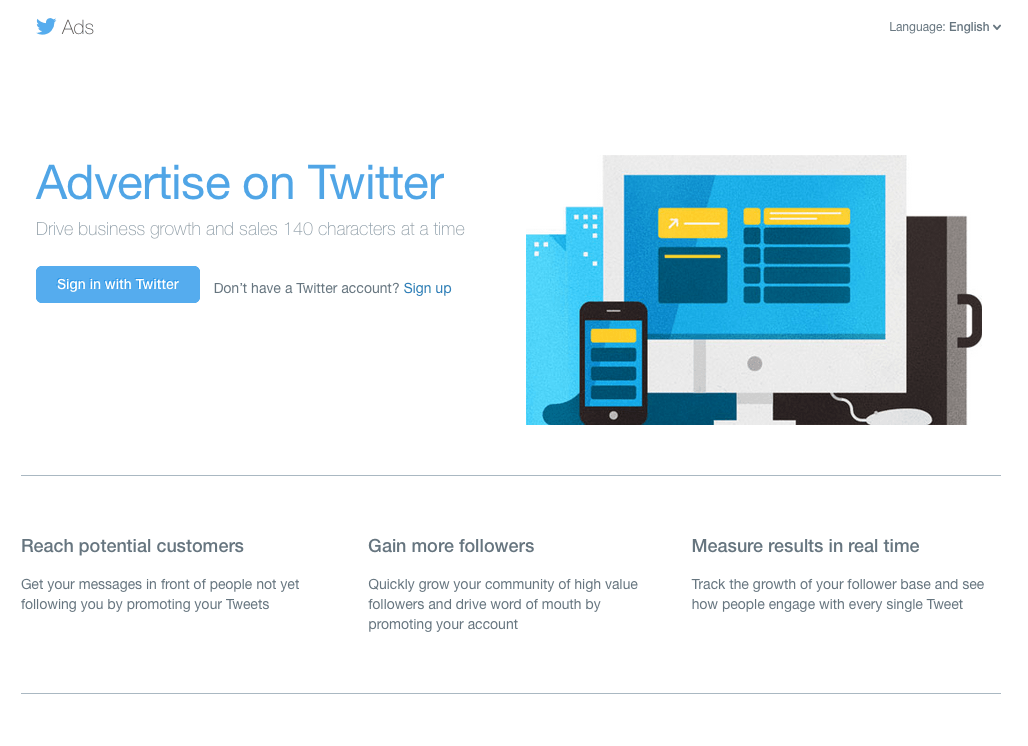 Written by ContentPowered.com
Written by ContentPowered.com
Twitter ads aren’t the most complex things in the world, but there’s still a surprising amount of depth to them, particularly if you’re going in expecting something like AdWords. Let’s get right in, shall we?
Ad Placement
There are only two locations for your ads on Twitter itself, the tweet feed and the account suggestion section.
The tweet feed has ads showing up as tweets, with the same image, size and character limits as normal tweets. The only difference is that the ads are shown to you as a paid promotion, and they have a little icon indicating that they are promoted. It’s down at the bottom, beneath the image.
The account suggestion section, to the left, is usually a list of people related to people you follow, or people who have something in common with the people you follow. Occasionally someone less related will appear, typically a brand name, usually followed by someone else you know. This looks and acts just like the usual account suggestion box, only it has the same yellow promoted icon to indicate it was paid.
On mobile, the two options are the same. Promoted tweets show up in the tweet feed, while promoted accounts show up in the Discover section.
Objectives
Similar to Facebook ads, Twitter ads have a selection of different objectives to choose from for your ads. Where on Facebook, you can go for a page like, a click to your website, a video view among others, Twitter has some unique options.
- Followers. This objective encourages users to follow your brand, through promoted tweets and through the account discovery section.
- Web Clicks. This objective is the standard PPC objective, getting users to click the link you’re promoting and visit your website. It’s only available in promoted tweets, not in the account discover section.
- Engagement. This objective tries to get users to retweet, respond, favorite or otherwise engage with a given tweet. Think of it sort of like Facebook’s basic Boost Post button. This only works in the tweet feed.
- App Objectives. There are two related app objectives; getting installs and getting engagement. These are valueless if you aren’t promoting your own Twitter-based app. If you are, these ads are great when they display in the tweet feed timeline.
- Lead Generation. Similar to website clicks, lead generation puts ads in the Twitter timeline to encourage users to click a “sign in” or “register” button, which will give you their email address.
Ad Types
Different ads have different ad types that go along with them. When you pick an objective, you are next asked to choose a type of ad for that objective. You can’t mix and match disparate objectives and ad types within the same campaign; you’ll need to make a new campaign.
- Promoted Account. This type is engineered to work in the sidebar for account discovery, or in the discover section of the mobile app. It can only be used with account promotion objectives, and does not combine or work with promoted tweets. Those will need a different objective.
- Promoted Tweets. These come in two flavors; organic and promoted. Organic tweets, when promoted, are visible at all times. They’re just like normal tweets, only they have bonus paid exposure. Promoted tweets are like Facebook’s dark posts, they don’t exist outside of the ads and only show up to the target audience.
- Lead Generation Cards. These cards are graphical banners that show up as tweets, but include a special CTA button to encourage users to sign up, giving you a lead.
- Website Cards. These cards are graphical banners that show a preview of the information at the other end of a link, much like how Facebook previews are generated. You can even customize them the same way, manually or through Twitter meta data on your website.
- App Install Cards. These are large graphical cards with a banner image for your app and a special CTA asking for app installs or app engagement, depending on the objective.
Ad Targeting
Targeting is, with most ad systems, the most important part of a successful campaign. Here are the targeting options you can use on Twitter.
- Location. This is very granular and can go from the country level all the way to individual postal codes.
- Gender. This is inferred from user information and posts, not directly posted on Twitter, so it’s not necessarily as accurate as Facebook gender targeting. Still, it’s effective for certain businesses..
- Language. As usual, add or restrict languages from your Twitter audience. Useful for limiting foreign language tweets to their receptive audiences, but not useful for English language tweets.
- Platform. This allows you to choose the type of platform you want to target, including mobile web, iOS, Android, desktop PC, various browser versions, and wi-fi only.
- Keyword. This is the same traditional keyword targeting you find everywhere. You can use broad, phrase, and exact matches, as well as their corresponding negative matches.
- Follower. You can specifically target just your followers, or a specific list of followers, or a list of followers similar to those followers of another account.
- Interest. Target specific interests, again inferred by Twitter.
- Audiences. This allows you to make a list of your website visitors, a specific list from another source, or “similar users” that operate much like Facebook’s lookalike audiences.
Bids
Twitter advertising works on a CPC system, and allows you to set a cap on the amount you want to spend each day. This resets each day at midnight Pacific, which is 3 a.m. Eastern. You can also control the pacing of your ads, between the normal rate of spending or an accelerated system that spends your ad budget as quickly as possible the moment it resets.
How you make use of all of these options depends on your goals, your ads themselves, your business and your budget. Twitter cards are highly useful, but you shouldn’t underestimate the power of promoted tweets when they’re timed properly. Accelerated bidding isn’t all that great for this reason, because it can dump your entire budget in the hour after midnight, when many of your users are asleep.

Useful list, thanks for this Eric!
I’m glad it helped, thanks Jamaal!